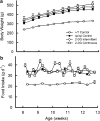Increased insulin sensitivity and reduced micro and macro vascular disease induced by 2-deoxy-D-glucose during metabolic syndrome in obese JCR: LA-cp rats
- PMID: 17375078
- PMCID: PMC2013948
- DOI: 10.1038/sj.bjp.0707226
Increased insulin sensitivity and reduced micro and macro vascular disease induced by 2-deoxy-D-glucose during metabolic syndrome in obese JCR: LA-cp rats
Abstract
Background and purpose: The metabolic syndrome, characterized by obesity, insulin resistance and dyslipidemia, is a major cause of cardiovascular disease. The origins of the syndrome have been hypothesized to lie in continuous availability of energy dense foods in modern societies. In contrast, human physiology has evolved in an environment of sporadic food supply and frequent food deprivation. Intermittent food restriction in rats has previously been shown to lead to reduction of cardiovascular risk and a greater life span. The non-metabolizable glucose analogue, 2-deoxy-D-glucose (2-DG) is taken up by cells and induces pharmacological inhibition of metabolism of glucose. We hypothesized that intermittent inhibition of glucose metabolism, a metabolic deprivation, may mimic intermittent food deprivation and ameliorate metabolic and pathophysiological aspects of the metabolic syndrome.
Experimental approach: Insulin resistant, atherosclerosis-prone JCR:LA-cp rats were treated with 2-DG (0.3% w/w in chow) on an intermittent schedule (2 days treated, one day non-treated, two days treated and two days non-treated) or continuously at a dose to give an equivalent averaged intake.
Key results: Intermittent 2-DG-treatment improved insulin sensitivity, which correlated with increased adiponectin concentrations. Further, intermittent treatment (but not continuous treatment) reduced plasma levels of leptin and the inflammatory cytokine IL-1 beta. Both 2-DG treatments reduced micro-vascular glomerular sclerosis, but only the intermittent schedule improved macro-vascular dysfunction.
Conclusions and implications: Our findings are consistent with reduction in severity of the metabolic syndrome and protection against end stage micro- and macro-vascular disease through intermittent metabolic deprivation at a cellular level by inhibition of glucose oxidation with 2-DG.
Figures








Similar articles
-
Pair feeding-mediated changes in metabolism: stress response and pathophysiology in insulin-resistant, atherosclerosis-prone JCR:LA-cp rats.Am J Physiol Endocrinol Metab. 2008 Jun;294(6):E1078-87. doi: 10.1152/ajpendo.90257.2008. Epub 2008 Apr 15. Am J Physiol Endocrinol Metab. 2008. PMID: 18413677
-
Synergistic effects of conjugated linoleic acid and chromium picolinate improve vascular function and renal pathophysiology in the insulin-resistant JCR:LA-cp rat.Diabetes Obes Metab. 2007 Jan;9(1):87-95. doi: 10.1111/j.1463-1326.2006.00578.x. Diabetes Obes Metab. 2007. PMID: 17199723
-
Rimonabant-mediated changes in intestinal lipid metabolism and improved renal vascular dysfunction in the JCR:LA-cp rat model of prediabetic metabolic syndrome.Am J Physiol Gastrointest Liver Physiol. 2010 Aug;299(2):G507-16. doi: 10.1152/ajpgi.00173.2010. Epub 2010 May 27. Am J Physiol Gastrointest Liver Physiol. 2010. PMID: 20508159
-
Metabolism and insulin signaling in common metabolic disorders and inherited insulin resistance.Dan Med J. 2014 Jul;61(7):B4890. Dan Med J. 2014. PMID: 25123125 Review.
-
Cardiovascular disease in the JCR:LA-cp rat.Mol Cell Biochem. 1998 Nov;188(1-2):113-26. Mol Cell Biochem. 1998. PMID: 9823017 Review.
Cited by
-
Irbesartan-mediated reduction of renal and cardiac damage in insulin resistant JCR : LA-cp rats.Br J Pharmacol. 2009 Nov;158(6):1588-96. doi: 10.1111/j.1476-5381.2009.00417.x. Epub 2009 Oct 8. Br J Pharmacol. 2009. PMID: 19814728 Free PMC article.
-
Activation of the NLRP3 inflammasome by islet amyloid polypeptide provides a mechanism for enhanced IL-1β in type 2 diabetes.Nat Immunol. 2010 Oct;11(10):897-904. doi: 10.1038/ni.1935. Epub 2010 Sep 12. Nat Immunol. 2010. PMID: 20835230 Free PMC article.
References
-
- Absher PM, Schneider DJ, Baldor LC, Russell JC, Sobel BE. The retardation of vasculopathy induced by attenuation of insulin resistance in the corpulent JCR: LA-cp rat is reflected by decreased vascular smooth muscle cell proliferation in vivo. Atherosclerosis. 1999;143:245–251. - PubMed
-
- Absher PM, Schneider DJ, Russell JC, Sobel BE. Increased proliferation of explanted vascular smooth muscle cells: a marker presaging atherogenesis. Atherosclerosis. 1997;131:187–194. - PubMed
-
- Ahmet I, Wan R, Mattson MP, Lakatta MD, Talan M. Cardioprotection by intermittent fasting in rats. Circulation. 2005;112:3115–3121. - PubMed
-
- Alemzadeh R, Tushaus KM. Modulation of adipoinsular axis in prediabetic Zucker diabetic fatty rats by diazoxide. Endocrinology. 2004;45:5476–5484. - PubMed
-
- Altomonte J, Harbaran S, Richter A, Dong H. Fat depot-specific expression of adiponectin is impaired in Zucker fatty rats. Metabolism. 2003;52:958–963. - PubMed
Publication types
MeSH terms
Substances
LinkOut - more resources
Full Text Sources
Medical
Miscellaneous

